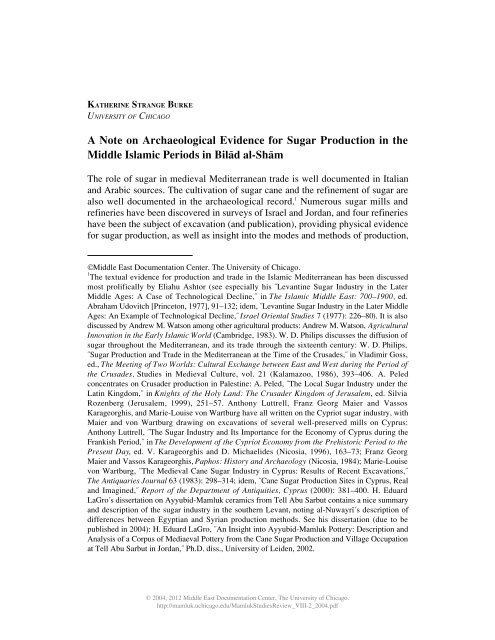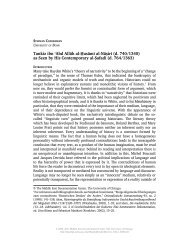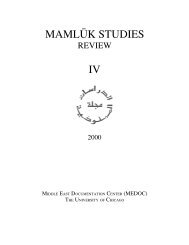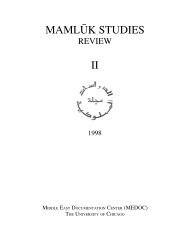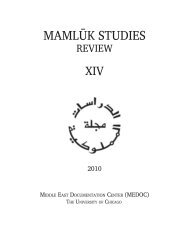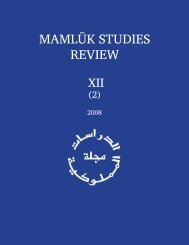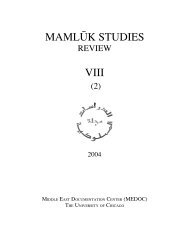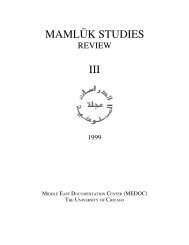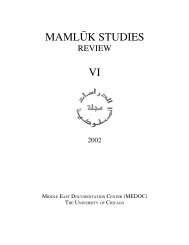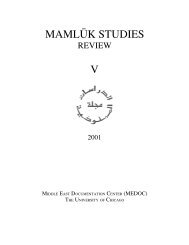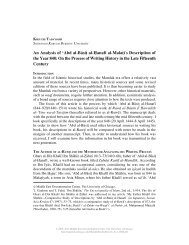A Note on Archaeological Evidence for Sugar Production in the ...
A Note on Archaeological Evidence for Sugar Production in the ...
A Note on Archaeological Evidence for Sugar Production in the ...
Create successful ePaper yourself
Turn your PDF publications into a flip-book with our unique Google optimized e-Paper software.
KATHERINE STRANGE BURKE<br />
UNIVERSITY OF CHICAGO<br />
A <str<strong>on</strong>g>Note</str<strong>on</strong>g> <strong>on</strong> <strong>Archaeological</strong> <strong>Evidence</strong> <strong>for</strong> <strong>Sugar</strong> Producti<strong>on</strong> <strong>in</strong> <strong>the</strong><br />
Middle Islamic Periods <strong>in</strong> Bila≠d al-Sha≠m<br />
The role of sugar <strong>in</strong> medieval Mediterranean trade is well documented <strong>in</strong> Italian<br />
and Arabic sources. The cultivati<strong>on</strong> of sugar cane and <strong>the</strong> ref<strong>in</strong>ement of sugar are<br />
also well documented <strong>in</strong> <strong>the</strong> archaeological record. 1 Numerous sugar mills and<br />
ref<strong>in</strong>eries have been discovered <strong>in</strong> surveys of Israel and Jordan, and four ref<strong>in</strong>eries<br />
have been <strong>the</strong> subject of excavati<strong>on</strong> (and publicati<strong>on</strong>), provid<strong>in</strong>g physical evidence<br />
<strong>for</strong> sugar producti<strong>on</strong>, as well as <strong>in</strong>sight <strong>in</strong>to <strong>the</strong> modes and methods of producti<strong>on</strong>,<br />
©Middle East Documentati<strong>on</strong> Center. The University of Chicago.<br />
1 The textual evidence <strong>for</strong> producti<strong>on</strong> and trade <strong>in</strong> <strong>the</strong> Islamic Mediterranean has been discussed<br />
most prolifically by Eliahu Ashtor (see especially his "Levant<strong>in</strong>e <strong>Sugar</strong> Industry <strong>in</strong> <strong>the</strong> Later<br />
Middle Ages: A Case of Technological Decl<strong>in</strong>e," <strong>in</strong> The Islamic Middle East: 700–1900, ed.<br />
Abraham Udovitch [Pr<strong>in</strong>cet<strong>on</strong>, 1977], 91–132; idem, "Levant<strong>in</strong>e <strong>Sugar</strong> Industry <strong>in</strong> <strong>the</strong> Later Middle<br />
Ages: An Example of Technological Decl<strong>in</strong>e," Israel Oriental Studies 7 (1977): 226–80). It is also<br />
discussed by Andrew M. Wats<strong>on</strong> am<strong>on</strong>g o<strong>the</strong>r agricultural products: Andrew M. Wats<strong>on</strong>, Agricultural<br />
Innovati<strong>on</strong> <strong>in</strong> <strong>the</strong> Early Islamic World (Cambridge, 1983). W. D. Philips discusses <strong>the</strong> diffusi<strong>on</strong> of<br />
sugar throughout <strong>the</strong> Mediterranean, and its trade through <strong>the</strong> sixteenth century: W. D. Philips,<br />
"<strong>Sugar</strong> Producti<strong>on</strong> and Trade <strong>in</strong> <strong>the</strong> Mediterranean at <strong>the</strong> Time of <strong>the</strong> Crusades," <strong>in</strong> Vladimir Goss,<br />
ed., The Meet<strong>in</strong>g of Two Worlds: Cultural Exchange between East and West dur<strong>in</strong>g <strong>the</strong> Period of<br />
<strong>the</strong> Crusades, Studies <strong>in</strong> Medieval Culture, vol. 21 (Kalamazoo, 1986), 393–406. A. Peled<br />
c<strong>on</strong>centrates <strong>on</strong> Crusader producti<strong>on</strong> <strong>in</strong> Palest<strong>in</strong>e: A. Peled, "The Local <strong>Sugar</strong> Industry under <strong>the</strong><br />
Lat<strong>in</strong> K<strong>in</strong>gdom," <strong>in</strong> Knights of <strong>the</strong> Holy Land: The Crusader K<strong>in</strong>gdom of Jerusalem, ed. Silvia<br />
Rozenberg (Jerusalem, 1999), 251–57. Anth<strong>on</strong>y Luttrell, Franz Georg Maier and Vassos<br />
Karageorghis, and Marie-Louise v<strong>on</strong> Wartburg have all written <strong>on</strong> <strong>the</strong> Cypriot sugar <strong>in</strong>dustry, with<br />
Maier and v<strong>on</strong> Wartburg draw<strong>in</strong>g <strong>on</strong> excavati<strong>on</strong>s of several well-preserved mills <strong>on</strong> Cyprus:<br />
Anth<strong>on</strong>y Luttrell, "The <strong>Sugar</strong> Industry and Its Importance <strong>for</strong> <strong>the</strong> Ec<strong>on</strong>omy of Cyprus dur<strong>in</strong>g <strong>the</strong><br />
Frankish Period," <strong>in</strong> The Development of <strong>the</strong> Cypriot Ec<strong>on</strong>omy from <strong>the</strong> Prehistoric Period to <strong>the</strong><br />
Present Day, ed. V. Karageorghis and D. Michaelides (Nicosia, 1996), 163–73; Franz Georg<br />
Maier and Vassos Karageorghis, Paphos: History and Archaeology (Nicosia, 1984); Marie-Louise<br />
v<strong>on</strong> Wartburg, "The Medieval Cane <strong>Sugar</strong> Industry <strong>in</strong> Cyprus: Results of Recent Excavati<strong>on</strong>s,"<br />
The Antiquaries Journal 63 (1983): 298–314; idem, "Cane <strong>Sugar</strong> Producti<strong>on</strong> Sites <strong>in</strong> Cyprus, Real<br />
and Imag<strong>in</strong>ed," Report of <strong>the</strong> Department of Antiquities, Cyprus (2000): 381–400. H. Eduard<br />
LaGro's dissertati<strong>on</strong> <strong>on</strong> Ayyubid-Mamluk ceramics from Tell Abu Sarbut c<strong>on</strong>ta<strong>in</strong>s a nice summary<br />
and descripti<strong>on</strong> of <strong>the</strong> sugar <strong>in</strong>dustry <strong>in</strong> <strong>the</strong> sou<strong>the</strong>rn Levant, not<strong>in</strong>g al-Nuwayr|'s descripti<strong>on</strong> of<br />
differences between Egyptian and Syrian producti<strong>on</strong> methods. See his dissertati<strong>on</strong> (due to be<br />
published <strong>in</strong> 2004): H. Eduard LaGro, "An Insight <strong>in</strong>to Ayyubid-Mamluk Pottery: Descripti<strong>on</strong> and<br />
Analysis of a Corpus of Mediaeval Pottery from <strong>the</strong> Cane <strong>Sugar</strong> Producti<strong>on</strong> and Village Occupati<strong>on</strong><br />
at Tell Abu Sarbut <strong>in</strong> Jordan," Ph.D. diss., University of Leiden, 2002.<br />
© 2004, 2012 Middle East Documentati<strong>on</strong> Center, The University of Chicago.<br />
http://mamluk.uchicago.edu/MamlukStudiesReview_VIII-2_2004.pdf
110 KATHERINE STRANGE BURKE, SUGAR PRODUCTION IN BILA≠D AL-SHA≠M<br />
throughout <strong>the</strong> regi<strong>on</strong> of Bila≠d al-Sha≠m. In additi<strong>on</strong>, excellent comparanda come<br />
from very well preserved sugar ref<strong>in</strong>eries dat<strong>in</strong>g to <strong>the</strong> late thirteenth to sixteenth<br />
centuries A.D. excavated <strong>in</strong> Cyprus, which, hav<strong>in</strong>g been modeled <strong>on</strong> <strong>the</strong> earlier<br />
and c<strong>on</strong>temporary Levant<strong>in</strong>e ref<strong>in</strong>eries, illustrate how <strong>the</strong> Levant<strong>in</strong>e <strong>in</strong>stallati<strong>on</strong>s<br />
may have functi<strong>on</strong>ed. 2 O<strong>the</strong>r comparanda come from Iran and North Africa: a<br />
ref<strong>in</strong>ery dat<strong>in</strong>g to <strong>the</strong> twelfth and thirteenth centuries A.D. was excavated at Susa, 3<br />
and several sites, probably sixteenth century and later, have been surveyed <strong>in</strong><br />
Morocco. 4 Although sources such as al-Qalqashand| and al-Nuwayr|, as well as<br />
Geniza letters and o<strong>the</strong>r trad<strong>in</strong>g documents, <strong>in</strong>dicate Islamic Egypt was awash <strong>in</strong><br />
sugar cane, <strong>the</strong>re have un<strong>for</strong>tunately been no published excavati<strong>on</strong>s <strong>in</strong> Egypt to<br />
accompany <strong>the</strong> textual evidence. 5<br />
In Bila≠d al-Sha≠m, four sugar factories have been excavated and published, all<br />
<strong>in</strong> <strong>the</strong> south, <strong>in</strong> modern Israel and Jordan. Tell Abu Qa’dan/Deir Alla <strong>in</strong> sou<strong>the</strong>rn<br />
Jordan was excavated by Henk J. Franken and Moawiyah M. Ibrahim <strong>in</strong> 1977 and<br />
1978, and <strong>the</strong> nearby Tell Abu Sarbut was excavated by Hubert de Haas, H.<br />
2<br />
Marie-Louise v<strong>on</strong> Wartburg, "Design and Technology of <strong>the</strong> Medieval Cane <strong>Sugar</strong> Ref<strong>in</strong>eries <strong>in</strong><br />
Cyprus: A Case Study <strong>in</strong> Industrial Archaeology," <strong>in</strong> Paisajes del Azúcar: Actas del Qu<strong>in</strong>to<br />
Sem<strong>in</strong>ario Internati<strong>on</strong>al Sobre la Can~a de Azúcar, ed. Ant<strong>on</strong>io Malpica (Granada, 1995), 81–116;<br />
v<strong>on</strong> Wartburg and Maier, "Excavati<strong>on</strong>s at Kouklia (Palaepaphos): 15th Prelim<strong>in</strong>ary Report: Seas<strong>on</strong>s<br />
1987–1988," Report of <strong>the</strong> Department of Antiquities, Cyprus (1989): 175–88. Also see Maier,<br />
"Excavati<strong>on</strong>s at Kouklia (Palaepaphos): N<strong>in</strong>th Prelim<strong>in</strong>ary Report: Seas<strong>on</strong> 1976," Report of <strong>the</strong><br />
Department of Antiquities, Cyprus (1977): 134–40; v<strong>on</strong> Wartburg and Maier, "Excavati<strong>on</strong>s at<br />
Kouklia (Palaepaphos): 16th Prelim<strong>in</strong>ary Report: Seas<strong>on</strong>s 1989 and 1990," Report of <strong>the</strong> Department<br />
of Antiquities, Cyprus (1991): 255–62.<br />
3<br />
Rémy Boucharlat and Audran Labrousse, "Une sucrerie d'époque islamique sur la rive droite du<br />
Chaour à Suse: I: Descripti<strong>on</strong> et essai d'<strong>in</strong>terprétati<strong>on</strong> des structures," Cahiers de la délégati<strong>on</strong><br />
archéologique française en Iran 10 (1979): 155–76; M<strong>on</strong>ik Kervran, "Une sucrerie d'époque<br />
islamique sur la rive droite du Chaour à Suse: II: Le matériel archéologique," Cahiers de la<br />
délégati<strong>on</strong> archéologique française en Iran 10 (1979): 177–237.<br />
4<br />
Paul Berthier, Les anciennes sucreries du Maroc et leurs réseaux hydrauliques, 2 vols. (Rabat,<br />
1966).<br />
5<br />
For example, Ashtor has culled Arab chr<strong>on</strong>iclers such as Ibn Duqma≠q and Ibn Mutawwaj <strong>for</strong><br />
lists of factory owners <strong>in</strong> both Cairo and Upper Egypt (Eliahu Ashtor, "Levant<strong>in</strong>e <strong>Sugar</strong> Industry<br />
<strong>in</strong> <strong>the</strong> Later Middle Ages: An Example of Technological Decl<strong>in</strong>e"). The Cairo Geniza documents,<br />
cover<strong>in</strong>g a slightly earlier period, also <strong>in</strong>dicate producti<strong>on</strong> and sale <strong>in</strong> Egypt: S. D. Goite<strong>in</strong>, A<br />
Mediterranean Society: The Jewish Communities of <strong>the</strong> Arab World as Portrayed <strong>in</strong> <strong>the</strong> Documents<br />
of <strong>the</strong> Cairo Geniza, vol. 1, Ec<strong>on</strong>omic Foundati<strong>on</strong>s (Berkeley, 1967); idem, "Mediterranean Trade<br />
<strong>in</strong> <strong>the</strong> Eleventh Century: Some Facts and Problems," <strong>in</strong> Studies <strong>in</strong> <strong>the</strong> Ec<strong>on</strong>omic History of <strong>the</strong><br />
Middle East: From <strong>the</strong> Rise of Islam to <strong>the</strong> Present Day, ed. M. A. Cook (L<strong>on</strong>d<strong>on</strong>, 1970), 51–62.<br />
Jean-Claude Garc<strong>in</strong> has compiled <strong>the</strong> sources <strong>for</strong> Qu≠s˝ and Upper Egypt: Jean-Claude Garc<strong>in</strong>, Un<br />
centre musulman de la Haute-Egypte médiévale, Qu≠s˝, Textes arabes et études islamiques no. 6<br />
(Cairo, 1976).<br />
© 2004, 2012 Middle East Documentati<strong>on</strong> Center, The University of Chicago.<br />
http://mamluk.uchicago.edu/MamlukStudiesReview_VIII-2_2004.pdf
MAMLU±K STUDIES REVIEW VOL. 8, NO. 2, 2004 111<br />
Eduard LaGro, and Margreet L. Ste<strong>in</strong>er <strong>in</strong> 1989, 1990, and 1992. 6 In Islamic<br />
Beisan (Roman-Byzant<strong>in</strong>e Scythopolis), excavati<strong>on</strong>s have revealed a Mamluk sugar<br />
factory mak<strong>in</strong>g use of part of <strong>the</strong> Crusader citadel <strong>the</strong>re. Brief descripti<strong>on</strong>s are<br />
<strong>in</strong>cluded <strong>in</strong> Ruth Gertwagen's report <strong>on</strong> <strong>the</strong> Abbasid-Fatimid <strong>for</strong>tress and<br />
surround<strong>in</strong>g Islamic settlement, 7 and by J<strong>on</strong> Seligman <strong>in</strong> his report <strong>on</strong> his excavati<strong>on</strong>s<br />
of <strong>the</strong> Crusader citadel. 8 Edna J. Stern has excavated a fairly well-preserved sugar<br />
ref<strong>in</strong>ery and associated mill <strong>in</strong> nor<strong>the</strong>rn Israel that dates to <strong>the</strong> Ayyubid and<br />
Mamluk periods. 9<br />
There are numerous mills extant <strong>in</strong> Palest<strong>in</strong>e and <strong>the</strong> Jordan valley, and numerous<br />
places are known from <strong>the</strong> textual sources to have grown sugar cane and<br />
manufactured sugar. All of <strong>the</strong> surveys of <strong>the</strong> Jordan valley at least menti<strong>on</strong> sites<br />
hav<strong>in</strong>g numerous sugar pots scattered <strong>on</strong> <strong>the</strong> surface, and some have described<br />
mill<strong>in</strong>g sites <strong>in</strong> detail. 10 Stern's M.A. <strong>the</strong>sis provides valuable survey data of <strong>the</strong><br />
<strong>for</strong>ty-three sites <strong>in</strong> Israel that have positive evidence of hav<strong>in</strong>g been sugar factories. 11<br />
She also lists those that may have produced sugar (twenty sites), and those that<br />
have been rumored to produce sugar but <strong>for</strong> which <strong>the</strong>re is no evidence (three<br />
6 Henk J. Franken and Mo’awiyah Ibrahim, "Two Seas<strong>on</strong>s of Excavati<strong>on</strong>s at Tell Deir 'Alla,<br />
1976–1978," Annual of <strong>the</strong> Department of Antiquities of Jordan 22 (1977–78): 57–80; Henk J.<br />
Franken and J. Kalsbeek, Potters of a Medieval Village <strong>in</strong> <strong>the</strong> Jordan Valley: Excavati<strong>on</strong>s at Tell<br />
Deir ’Alla≠—a Medieval Tell, Tell Abu Gourdan, Jordan (Amsterdam, 1975); Hubert de Haas et<br />
al., "First Seas<strong>on</strong> of Excavati<strong>on</strong>s at Tell Abu Sarbut, 1988: A Prelim<strong>in</strong>ary Report," ADAJ 33<br />
(1989): 323–26; idem, "Sec<strong>on</strong>d and Third Seas<strong>on</strong>s of Excavati<strong>on</strong>s at Tell Abu Sarbut, Jordan<br />
Valley (Prelim<strong>in</strong>ary Report)," ADAJ 36 (1992): 333–43.<br />
7 Ruth Gertwagen, "The Fortress (of Bet She'an)," Excavati<strong>on</strong>s and Surveys <strong>in</strong> Israel 11 (1989–91):<br />
56–59.<br />
8 J. Seligman, "Bet She'an, <strong>the</strong> Citadel," Excavati<strong>on</strong>s and Surveys <strong>in</strong> Israel 15 (1996): 43–47.<br />
9 Edna J. Stern, "The Excavati<strong>on</strong>s at Lower Horbat Manot: A Medieval <strong>Sugar</strong>-Producti<strong>on</strong> Site,"<br />
'Atiqot 42 (2001): 277–308.<br />
10 See especially Mo’awiyah Ibrahim et al., "The East Jordan Valley Survey, 1975," Bullet<strong>in</strong> of <strong>the</strong><br />
American Schools of Oriental Research 222 (1976): 41–66; idem, "The East Jordan Valley Survey,<br />
1976 (Part Two)," <strong>in</strong> Archaeology of Jordan: Essays and Reports, ed. Khair Yass<strong>in</strong>e (Amman,<br />
1988), 203; G. R. D. K<strong>in</strong>g, "Survey of Byzant<strong>in</strong>e and Islamic Sites <strong>in</strong> Jordan: Third Seas<strong>on</strong><br />
Prelim<strong>in</strong>ary Report (1982): The Sou<strong>the</strong>rn Ghôr," ADAJ 31 (1987): 39–460; idem, "Survey of<br />
Byzant<strong>in</strong>e and Islamic Sites <strong>in</strong> Jordan: Third prelim<strong>in</strong>ary report (1982): The Wadi Arabah (Part<br />
2)," ADAJ 33 (1989): 203; B. MacD<strong>on</strong>ald, The Wadi el Hasa <strong>Archaeological</strong> Survey 1979–1983,<br />
West-Central Jordan (Waterloo, Ontario, 1988); idem, "The Sou<strong>the</strong>rn Ghors and Nor<strong>the</strong>ast 'Arabah<br />
<strong>Archaeological</strong> Survey, 1986, Jordan: A Prelim<strong>in</strong>ary Report," ADAJ 31 (1987): 410; D<strong>on</strong>ald S.<br />
Whitcomb, "The Islamic Period as Seen from Selected Sites," <strong>in</strong> The Sou<strong>the</strong>rn Ghors and Nor<strong>the</strong>ast<br />
'Arabah <strong>Archaeological</strong> Survey, Sheffield <strong>Archaeological</strong> M<strong>on</strong>ographs, no. 5, ed. B. MacD<strong>on</strong>ald<br />
(Sheffield, 1992), 113–18.<br />
11 Ms. Stern has generously e-mailed me <strong>the</strong> tables from her M.A. <strong>the</strong>sis <strong>in</strong> English.<br />
© 2004, 2012 Middle East Documentati<strong>on</strong> Center, The University of Chicago.<br />
http://mamluk.uchicago.edu/MamlukStudiesReview_VIII-2_2004.pdf
112 KATHERINE STRANGE BURKE, SUGAR PRODUCTION IN BILA≠D AL-SHA≠M<br />
sites). 12 Fifty-<strong>on</strong>e possible sugar-produc<strong>in</strong>g sites <strong>in</strong> Palest<strong>in</strong>e have also been collected<br />
from survey and textual sources and summarized by Brigitte Porëe-Braitowsky <strong>in</strong><br />
a l<strong>on</strong>g article that also relies <strong>on</strong> some of her own rec<strong>on</strong>naissance. 13 This number is<br />
mostly a count of mill<strong>in</strong>g sites, <strong>for</strong> which <strong>the</strong>re is no direct archaeological evidence<br />
of sugar producti<strong>on</strong>, however. Here we are c<strong>on</strong>cerned with those sites that have<br />
been excavated or surveyed, and found to c<strong>on</strong>ta<strong>in</strong> <strong>the</strong> best proof <strong>the</strong>re is <strong>for</strong> sugar<br />
producti<strong>on</strong>, which is <strong>the</strong> presence of great quantities of sherds of both c<strong>on</strong>ical<br />
sugar molds and syrup jars. 14 Boiled, reduced cane juice (collected from chopped<br />
and crushed sugar cane) was poured <strong>in</strong>to <strong>the</strong> molds, which were c<strong>on</strong>ical, hav<strong>in</strong>g a<br />
wide mouth and narrow base, and had <strong>on</strong>e to three small holes punched <strong>in</strong> <strong>the</strong><br />
base. The molds were ei<strong>the</strong>r set directly <strong>on</strong> or raised over syrup jars, which<br />
collected <strong>the</strong> liquid slowly dra<strong>in</strong><strong>in</strong>g from <strong>the</strong> mold. This slow dra<strong>in</strong><strong>in</strong>g, as well as<br />
evaporati<strong>on</strong> of liquid, resulted <strong>in</strong> a c<strong>on</strong>e-shaped cake of sugar. The collected syrup<br />
might be re-boiled and poured aga<strong>in</strong> <strong>in</strong>to molds, or sold <strong>in</strong> its own right. 15 The<br />
sugar molds were often broken dur<strong>in</strong>g <strong>the</strong> removal of <strong>the</strong> sugar cake, result<strong>in</strong>g <strong>in</strong><br />
great quantities of broken pottery rema<strong>in</strong><strong>in</strong>g at sugar-producti<strong>on</strong> sites, and likely<br />
<strong>on</strong>-site producti<strong>on</strong> of pottery. 16<br />
12 Edna J. Stern, "The <strong>Sugar</strong> Industry <strong>in</strong> Palest<strong>in</strong>e dur<strong>in</strong>g <strong>the</strong> Crusader, Ayyubid, and Mamluk<br />
Periods <strong>in</strong> Light of <strong>the</strong> <strong>Archaeological</strong> F<strong>in</strong>ds," M.A. <strong>the</strong>sis, Hebrew University, 1999. There are<br />
numerous such sites <strong>in</strong> this regi<strong>on</strong>. For example, <strong>the</strong> excavators at Caesarea believe <strong>the</strong>y have<br />
discovered an Abbasid-period mill used <strong>for</strong> sugar, which would have been animal-driven. They<br />
cite no evidence bey<strong>on</strong>d <strong>the</strong> mill itself, but Caesarea was known as <strong>on</strong>e of <strong>the</strong> more important sites<br />
of sugar producti<strong>on</strong> <strong>in</strong> <strong>the</strong> early Islamic period. See Avner Raban, "Comb<strong>in</strong>ed Caesarea Excavati<strong>on</strong>s<br />
(B)," Excavati<strong>on</strong>s and Surveys <strong>in</strong> Israel 17 (1998): 58–76. (I am grateful to Asa Eger <strong>for</strong> this<br />
reference.)<br />
13 Brigitte Porëe-Braitowsky, "Les moul<strong>in</strong>s et fabriques à sucre de Palest<strong>in</strong>e et de Chypre: Histoire,<br />
geographie et technologie d'une producti<strong>on</strong> croisee et medievale," <strong>in</strong> Kypros kai oi<br />
Staurophories/Cyprus and <strong>the</strong> Crusades: Papers given at <strong>the</strong> Internati<strong>on</strong>al C<strong>on</strong>ference 'Cyprus<br />
and <strong>the</strong> Crusades,' Nicosia, 6–9 September, 1994, ed. Nicholas Coureas and J<strong>on</strong>athan Riley-Smith<br />
(Nicosia, 1995), 377–510.<br />
14 Mill<strong>in</strong>g sites that are not accompanied by this ceramic evidence could not have been used <strong>for</strong><br />
sugar, although it has been argued that some of <strong>the</strong>m may have been built <strong>for</strong> gr<strong>in</strong>d<strong>in</strong>g sugar cane<br />
and were later used <strong>for</strong> gra<strong>in</strong>.<br />
15 The rec<strong>on</strong>structi<strong>on</strong> of sugar producti<strong>on</strong> comes from al-Nuwayr|, and from <strong>the</strong> above-menti<strong>on</strong>ed<br />
excavati<strong>on</strong>s at Kouklia, Cyprus. See LaGro's useful summary of al-Nuwayr|'s descripti<strong>on</strong> <strong>in</strong> his<br />
dissertati<strong>on</strong> (LaGro, "An Insight <strong>in</strong>to Ayyubid-Mamluk Pottery," 30–31, or al-Nuwayr|, Niha≠yat<br />
al-Arab f| Funu≠n al-Adab, vol. 7 (Cairo, 1931).<br />
16 Berthier, Les anciennes sucreries du Maroc; Franken and Kalsbeek, Potters of a Medieval<br />
Village; v<strong>on</strong> Wartburg, "The Medieval Cane <strong>Sugar</strong> Industry <strong>in</strong> Cyprus."<br />
© 2004, 2012 Middle East Documentati<strong>on</strong> Center, The University of Chicago.<br />
http://mamluk.uchicago.edu/MamlukStudiesReview_VIII-2_2004.pdf
MAMLU±K STUDIES REVIEW VOL. 8, NO. 2, 2004 113<br />
Summaries of <strong>the</strong> excavati<strong>on</strong>s known to date illustrate what is known and possible<br />
to know from <strong>the</strong> archaeological evidence:<br />
Tell Deir Alla is a large mound <strong>in</strong> <strong>the</strong> east side of <strong>the</strong> Jordan valley, close to<br />
<strong>the</strong> Zerqa’ river. Excavati<strong>on</strong>s from 1960 to 1967 by Henk J. Franken of <strong>the</strong><br />
University of Leiden revealed <strong>in</strong>tensive Late Br<strong>on</strong>ze Age and Ir<strong>on</strong> Age occupati<strong>on</strong>,<br />
but <strong>in</strong> <strong>the</strong> Islamic periods <strong>the</strong> site was used as a cemetery, presumably<br />
c<strong>on</strong>temporaneous with <strong>the</strong> adjacent site of Tell Abu Qa’dan. 17 Some of <strong>the</strong> grave<br />
goods <strong>in</strong>clude sugar molds and syrup jars. 18 At Tell Abu Qa’dan, nor<strong>the</strong>ast of Deir<br />
Alla, mills were still visible <strong>in</strong> <strong>the</strong> early twentieth century several hundred meters<br />
to <strong>the</strong> east of <strong>the</strong> tell. 19 Because of its presumed relati<strong>on</strong>ship with Tell Deir Alla, it<br />
was excavated briefly <strong>in</strong> 1967 by M. Jamerah of <strong>the</strong> Department of Antiquities.<br />
These excavati<strong>on</strong>s and a detailed ceramic study were published by Franken and J.<br />
Kalsbeek, provid<strong>in</strong>g <strong>the</strong> most detailed study extant of sugar vessels from this<br />
regi<strong>on</strong>. 20 Only two 5 m x 5 m trenches were dug, with most of <strong>the</strong> work c<strong>on</strong>centrat<strong>in</strong>g<br />
<strong>on</strong> <strong>on</strong>e trench. The excavators reached a depth of 6.5 m, of material that <strong>the</strong>y<br />
dated from <strong>the</strong> eighth to <strong>the</strong> fifteenth centuries A.D. 21 In trench DA/AR100 a<br />
series of courtyard levels was excavated, each c<strong>on</strong>ta<strong>in</strong><strong>in</strong>g pottery, ash, and thick<br />
clay deposits from collapsed walls, as well as some pits and thick ash deposits.<br />
Bread ovens were also found. The excavators emphasize that <strong>the</strong> most surpris<strong>in</strong>g<br />
aspect of <strong>the</strong> excavati<strong>on</strong> was <strong>the</strong> very large quantity of ceramic recovered from<br />
<strong>the</strong> courtyards, <strong>in</strong>clud<strong>in</strong>g several pots smashed <strong>in</strong> situ by a collapsed wall, and<br />
thus able to be rec<strong>on</strong>structed. Partly because of <strong>the</strong> nature of <strong>the</strong> depositi<strong>on</strong>, and<br />
partly because of <strong>the</strong> speed of excavati<strong>on</strong>, <strong>the</strong> excavators were unable to get good<br />
stratigraphic differentiati<strong>on</strong>. All <strong>the</strong> dat<strong>in</strong>g is d<strong>on</strong>e <strong>on</strong> <strong>the</strong> basis of ceramic analysis,<br />
not stratigraphy. Thus Franken and Kalsbeek differentiate three phases of<br />
occupati<strong>on</strong>, or at least of ceramic producti<strong>on</strong>, but <strong>the</strong>y are unable to anchor <strong>the</strong>m<br />
to an absolute chr<strong>on</strong>ology.<br />
The greatest quantity of sherds from <strong>the</strong> site is of two types, present <strong>on</strong>ly <strong>in</strong><br />
17<br />
Franken and Ibrahim, "Two Seas<strong>on</strong>s of Excavati<strong>on</strong>s at Tell Deir 'Alla, 1976–1978." (Abu<br />
Qa’dan is spelled Abu Gourdan <strong>in</strong> <strong>the</strong> publicati<strong>on</strong>s.)<br />
18<br />
The cemetery was aga<strong>in</strong> excavated <strong>in</strong> 1976–78 by a jo<strong>in</strong>t expediti<strong>on</strong> of <strong>the</strong> University of Leiden<br />
and <strong>the</strong> Jordanian Department of Antiquities, directed by H. J. Franken and M. M. Ibrahim.<br />
19<br />
Franken and Kalsbeek, Potters of a Medieval Village, 219.<br />
20<br />
Ibid.<br />
21<br />
James A. Sauer questi<strong>on</strong>s <strong>the</strong> basis <strong>for</strong> <strong>the</strong>se dates, as Franken and Kalsbeek make <strong>on</strong>ly a few<br />
general comparis<strong>on</strong>s of <strong>the</strong>ir pottery with o<strong>the</strong>r sites, and make no attempt to sort through <strong>the</strong><br />
n<strong>in</strong>eteen layers of stratigraphy. James A. Sauer, "Pottery Techniques at Tell Deir 'Alla," Bullet<strong>in</strong> of<br />
<strong>the</strong> American Schools of Oriental Research 222 (1976): 91–94. LaGro's dissertati<strong>on</strong> is meant to<br />
follow up <strong>on</strong> and perhaps improve up<strong>on</strong> Franken and Kalsbeek's ceramic study: LaGro, "An<br />
Insight <strong>in</strong>to Ayyubid-Mamluk Pottery."<br />
© 2004, 2012 Middle East Documentati<strong>on</strong> Center, The University of Chicago.<br />
http://mamluk.uchicago.edu/MamlukStudiesReview_VIII-2_2004.pdf
114 KATHERINE STRANGE BURKE, SUGAR PRODUCTION IN BILA≠D AL-SHA≠M<br />
<strong>the</strong> latter two phases of <strong>the</strong> site. Thousands of body sherds were found bel<strong>on</strong>g<strong>in</strong>g<br />
to <strong>the</strong> above-described sugar-pots: c<strong>on</strong>ical molds (<strong>the</strong>se hav<strong>in</strong>g a s<strong>in</strong>gle small hole<br />
<strong>in</strong> <strong>the</strong> base) and syrup jars, which are generally described as "bag-shaped," and are<br />
handle-less and almost rimless. Both types of sugar pot are usually of somewhat<br />
coarse red- or white-fir<strong>in</strong>g wares, thickly potted. Only <strong>the</strong> <strong>in</strong>teriors of <strong>the</strong> molds<br />
are smoo<strong>the</strong>d. Accord<strong>in</strong>g to Franken and Kalsbeek's study of those at Deir Alla<br />
and Abu Qa’dan, <strong>the</strong>y are made with a comb<strong>in</strong>ati<strong>on</strong> of coil-built and wheel-thrown<br />
techniques. The molds come <strong>in</strong> various heights, keep<strong>in</strong>g a generally standard rim<br />
diameter. They seem to be roughly standardized to three different capacities. The<br />
same rim variati<strong>on</strong>s occur <strong>in</strong> each phase, mak<strong>in</strong>g rim changes useless <strong>for</strong> chr<strong>on</strong>ology.<br />
Syrup jars are likewise c<strong>on</strong>sistent <strong>in</strong> shape and capacity throughout <strong>the</strong> periods.<br />
The vast majority of both molds and jars are pla<strong>in</strong>, but <strong>the</strong>re are rare examples of<br />
decorated sugar molds, hav<strong>in</strong>g combed decorati<strong>on</strong> or even a dark green glaze. 22<br />
The sheer quantity of ceramics related to <strong>the</strong> sugar <strong>in</strong>dustry, al<strong>on</strong>g with <strong>the</strong> presence<br />
of some vitrified sherds, <strong>in</strong>dicates that <strong>the</strong>y may have been produced <strong>on</strong> site to<br />
meet <strong>the</strong> high demands of sugar producti<strong>on</strong>. 23 The courtyards <strong>the</strong>mselves may<br />
represent <strong>the</strong> rema<strong>in</strong>s of a ref<strong>in</strong>ery, used over a l<strong>on</strong>g period of time.<br />
Tell Abu Sarbut, <strong>on</strong>ly about 1.5 km west-northwest of Tell Deir Alla and Tell<br />
Abu Qa’dan, was excavated by Hubert de Haas, H. Eduard LaGro and Margreet<br />
L. Ste<strong>in</strong>er <strong>in</strong> 1989, 1990, and 1992. Although no rema<strong>in</strong>s of ei<strong>the</strong>r a mill or a<br />
press were found, <strong>the</strong> excavators did f<strong>in</strong>d part of a large build<strong>in</strong>g that may have<br />
been used as a ref<strong>in</strong>ery, with two ma<strong>in</strong> phases of use some time apart. In its<br />
sec<strong>on</strong>d phase <strong>the</strong>re were benches with sugar molds embedded <strong>in</strong> <strong>the</strong>m, ready to<br />
hold o<strong>the</strong>r sugar molds <strong>in</strong>to which <strong>the</strong> boiled sugar cane juice would be poured.<br />
Many fragments of sugar molds and jars were also found here. Ano<strong>the</strong>r part of <strong>the</strong><br />
tell revealed a domestic area c<strong>on</strong>ta<strong>in</strong><strong>in</strong>g four phases of Ayyubid-Mamluk occupati<strong>on</strong><br />
built directly over unexcavated Byzant<strong>in</strong>e rema<strong>in</strong>s. Material culture <strong>in</strong>cluded<br />
numerous ceramics, but also fragments of glass bracelets and pieces of ir<strong>on</strong> and<br />
br<strong>on</strong>ze. The dat<strong>in</strong>g of this area and <strong>the</strong> factory was based <strong>on</strong> calibrated 14 C dates. 24<br />
They date <strong>the</strong> last phase of <strong>the</strong> domestic area, which is evidence of <strong>the</strong> village, to<br />
A.D. 1434–1510 or 1598–1620, and <strong>the</strong> phase succeed<strong>in</strong>g <strong>the</strong> last phase of <strong>the</strong><br />
factory to 1292–1448. Thus <strong>the</strong> factories could have been late Ayyubid or early<br />
22 Franken and Kalsbeek, Potters of a Medieval Village, 143–46.<br />
23 For comparis<strong>on</strong>, <strong>the</strong> fourteenth–fifteenth-century sugar mill at Kouklia <strong>on</strong> Cyprus <strong>in</strong>cluded a<br />
simple round kiln <strong>for</strong> manufactur<strong>in</strong>g <strong>the</strong> molds and jars <strong>on</strong> site (v<strong>on</strong> Wartburg, "The Medieval<br />
Cane <strong>Sugar</strong> Industry <strong>in</strong> Cyprus"). Generally <strong>the</strong> quantity of specialized vessels <strong>for</strong> sugar producti<strong>on</strong><br />
is so high at each site that it <strong>on</strong>ly seems reas<strong>on</strong>able to assume that <strong>the</strong>y were manufactured <strong>on</strong>-site.<br />
24 The reports do not disclose what material was used <strong>for</strong> <strong>the</strong> 14 C samples or how many samples<br />
were taken.<br />
© 2004, 2012 Middle East Documentati<strong>on</strong> Center, The University of Chicago.<br />
http://mamluk.uchicago.edu/MamlukStudiesReview_VIII-2_2004.pdf
MAMLU±K STUDIES REVIEW VOL. 8, NO. 2, 2004 115<br />
Mamluk. We may <strong>in</strong>fer that <strong>the</strong> village was not completely dependent up<strong>on</strong> <strong>the</strong><br />
success of <strong>the</strong> factories, <strong>for</strong> it rema<strong>in</strong>ed occupied <strong>for</strong> at least a century after <strong>the</strong><br />
last use of <strong>the</strong> factory. 25<br />
Beisan or Bet She’an, Byzant<strong>in</strong>e Scythopolis, also possesses evidence of sugar<br />
producti<strong>on</strong> <strong>in</strong> its later periods. It has been excavated by numerous <strong>in</strong>stituti<strong>on</strong>s, but<br />
we are c<strong>on</strong>cerned with two projects: <strong>the</strong> Bet She’an Excavati<strong>on</strong> Project <strong>in</strong> cooperati<strong>on</strong><br />
with <strong>the</strong> Department of Archaeology of Haifa University excavated <strong>the</strong> area of<br />
<strong>in</strong>terest to us <strong>in</strong> August–October 1989 and May–November 1990 under <strong>the</strong> directi<strong>on</strong><br />
of Ruth Gertwagen and Adrian Boaz; and <strong>the</strong> Israel Antiquities Authority excavated<br />
<strong>in</strong> <strong>the</strong> summers of 1992, 1993, and 1994 under <strong>the</strong> directi<strong>on</strong> of J<strong>on</strong> Seligman. In<br />
<strong>the</strong> lower town, <strong>in</strong> an area about 400 m west of <strong>the</strong> center of <strong>the</strong> Roman-Byzant<strong>in</strong>e<br />
town, <strong>the</strong>re is an area of occupati<strong>on</strong> dat<strong>in</strong>g from <strong>the</strong> Byzant<strong>in</strong>e through <strong>the</strong> Ottoman<br />
periods, centered around <strong>the</strong> Crusader citadel. The citadel appears to have been<br />
built over an earlier <strong>for</strong>tress from <strong>the</strong> Abbasid-Fatimid periods. In <strong>the</strong> early Mamluk<br />
period a complex of <strong>in</strong>stallati<strong>on</strong>s <strong>for</strong> <strong>the</strong> manufacture of sugar was built <strong>in</strong>side <strong>the</strong><br />
citadel's <strong>in</strong>ner rooms, keep, and part of <strong>the</strong> moat, as well as over <strong>the</strong> basalt<br />
build<strong>in</strong>gs to <strong>the</strong> north of <strong>the</strong> citadel, which may be <strong>in</strong>terpreted as houses built<br />
around a courtyard. The pr<strong>in</strong>cipal evidence <strong>for</strong> sugar manufacture is <strong>the</strong> presence<br />
of thousands of sherds of sugar pots ly<strong>in</strong>g <strong>on</strong> a lime floor. Seligman also noted<br />
"compartments built al<strong>on</strong>g <strong>the</strong> walls to support vessels used <strong>in</strong> <strong>the</strong> sugar <strong>in</strong>dustry,"<br />
presumably sugar molds. 26 Un<strong>for</strong>tunately nei<strong>the</strong>r Gertwagen nor Seligman describe<br />
<strong>the</strong> f<strong>in</strong>ds <strong>in</strong> detail, although Seligman notes <strong>the</strong>y found no <strong>in</strong>stallati<strong>on</strong>s <strong>for</strong> process<strong>in</strong>g<br />
<strong>the</strong> cane itself (i.e., a press). In any case <strong>the</strong> <strong>in</strong>dustry appears to have been<br />
short-lived <strong>in</strong> this locati<strong>on</strong>, and by <strong>the</strong> late Ottoman period <strong>the</strong> citadel's upper<br />
story was rebuilt and used as a school.<br />
Excavati<strong>on</strong>s at Yesud HaMa’ala <strong>in</strong> <strong>the</strong> Galilee have revealed <strong>the</strong> <strong>in</strong>terest<strong>in</strong>g<br />
build<strong>in</strong>g sequence of a possible synagogue cum sugar factory. 27 Yesud HaMa’ala<br />
is <strong>in</strong> eastern Galilee, <strong>on</strong> <strong>the</strong> east bank of <strong>the</strong> Jordan, about 15 km north of Safed.<br />
Excavati<strong>on</strong>s were carried out <strong>the</strong>re <strong>in</strong> 1883, 1970, and 1974–83 by Y. Shoram,<br />
25 De Haas et al., "First Seas<strong>on</strong> of Excavati<strong>on</strong>s at Tell Abu Sarbut"; idem, "Sec<strong>on</strong>d and Third<br />
Seas<strong>on</strong>s of Excavati<strong>on</strong>s at Tell Abu Sarbut"; LaGro, "An Insight <strong>in</strong>to Ayyubid-Mamluk Pottery. "<br />
26 Seligman, "Bet She'an, <strong>the</strong> Citadel."<br />
27 Although <strong>the</strong>re are four short publicati<strong>on</strong>s by <strong>the</strong> excavators <strong>in</strong> Hebrew, I have relied most<br />
heavily <strong>on</strong> <strong>the</strong> summary <strong>in</strong> French by Porëe-Braitowsky. A. Biran, "Yesud HaMa'ala," <strong>in</strong> The New<br />
Encyclopedia of <strong>Archaeological</strong> Excavati<strong>on</strong>s <strong>in</strong> <strong>the</strong> Holy Land (Jerusalem, 1993), 4:1510; Biran<br />
and Shoram, "Rema<strong>in</strong>s of a Synagogue and of a <strong>Sugar</strong> Installati<strong>on</strong> at Yesud HaMa'alah" (<strong>in</strong><br />
Hebrew), Eretz-Israel, <strong>Archaeological</strong>, Historical and Geographical Studies 19 (1987); A. Biran<br />
and Dan Urman, "Yesud HaMa'ala, Synagogue—1982–1983" (<strong>in</strong> Hebrew), Excavati<strong>on</strong>s and Surveys<br />
<strong>in</strong> Israel 2 (1983): 110–11; Porëe-Braitowsky, "Les moul<strong>in</strong>s et fabriques à sucre de Palest<strong>in</strong>e et de<br />
Chypre."<br />
© 2004, 2012 Middle East Documentati<strong>on</strong> Center, The University of Chicago.<br />
http://mamluk.uchicago.edu/MamlukStudiesReview_VIII-2_2004.pdf
116 KATHERINE STRANGE BURKE, SUGAR PRODUCTION IN BILA≠D AL-SHA≠M<br />
Avraham Biran, and Dan Urman. The build<strong>in</strong>g hous<strong>in</strong>g <strong>the</strong> sugar factory seems to<br />
be undated. The entire twenty-<strong>on</strong>e meter length of <strong>the</strong> south wall was uncovered<br />
to a height of 1.5 m. The <strong>in</strong>terior space of <strong>the</strong> build<strong>in</strong>g was divided with two rows<br />
of columns. In its latest phase <strong>the</strong> three spaces provided by <strong>the</strong> rows of columns<br />
each held a plastered bas<strong>in</strong> <strong>in</strong> and around which numerous fragments of sugar<br />
molds and jars were discovered. The bas<strong>in</strong>s each <strong>in</strong>corporated a column base.<br />
Fur<strong>the</strong>r evidence of sugar ref<strong>in</strong><strong>in</strong>g was <strong>the</strong> presence of a five-meter-l<strong>on</strong>g st<strong>on</strong>e<br />
canal, provid<strong>in</strong>g <strong>the</strong> water necessary <strong>for</strong> <strong>the</strong> process of sugar ref<strong>in</strong><strong>in</strong>g.<br />
The ceramics, <strong>in</strong>clud<strong>in</strong>g those of <strong>the</strong> sugar pots, were dated <strong>on</strong> <strong>the</strong> basis of <strong>on</strong>e<br />
Crusader co<strong>in</strong> m<strong>in</strong>ted <strong>in</strong> Cyprus to <strong>the</strong> thirteenth century, to which <strong>the</strong> excavators<br />
date <strong>the</strong> last phase of use of <strong>the</strong> build<strong>in</strong>g. The excavators claim that <strong>the</strong>re were no<br />
ceramics later than <strong>the</strong> medieval period, and also that <strong>the</strong>re were no Roman or<br />
Byzant<strong>in</strong>e sherds. The col<strong>on</strong>naded build<strong>in</strong>g is never<strong>the</strong>less identified as a synagogue<br />
based <strong>on</strong> an Aramean <strong>in</strong>scripti<strong>on</strong> found <strong>on</strong> <strong>the</strong> site, al<strong>on</strong>g with architectural<br />
similarities with those at Gush Halav and Capernaum, which date to <strong>the</strong> fourth<br />
through sixth centuries A.D.<br />
Excavati<strong>on</strong>s at Lower Horbat Manot provide <strong>the</strong> f<strong>in</strong>al example of an excavated<br />
sugar ref<strong>in</strong>ery <strong>in</strong> Bila≠d al-Sha≠m. This was a salvage excavati<strong>on</strong> c<strong>on</strong>ducted by <strong>the</strong><br />
Israel Antiquities Authority <strong>in</strong> 1995. At this site, <strong>on</strong> <strong>the</strong> Acre pla<strong>in</strong> about 12 km<br />
nor<strong>the</strong>ast of Acre, a ref<strong>in</strong>ery and aqueduct were built by Godfrey le Tor <strong>in</strong> <strong>the</strong><br />
thirteenth century A.D. (who sold it to <strong>the</strong> Hospitallers, who <strong>in</strong> turn leased it to<br />
<strong>the</strong> Teut<strong>on</strong>ic Knights of M<strong>on</strong>t<strong>for</strong>t) and rema<strong>in</strong>ed <strong>in</strong> operati<strong>on</strong> under Mamluk and<br />
<strong>the</strong>n Ottoman governance. 28 A screw-press nearby was likely <strong>the</strong> site of sugar<br />
cane crush<strong>in</strong>g, be<strong>for</strong>e it was taken to <strong>the</strong> ref<strong>in</strong>ery to be boiled. The excavati<strong>on</strong> of<br />
<strong>the</strong> site was <strong>in</strong>complete, but <strong>the</strong> excavators did establish <strong>the</strong> locati<strong>on</strong> of <strong>the</strong> build<strong>in</strong>g<br />
that would have housed <strong>the</strong> fire pits over which cauldr<strong>on</strong>s of cane juice would<br />
have been boiled, and <strong>the</strong>y fully excavated <strong>the</strong> courtyard where <strong>the</strong> cakes of sugar<br />
were dried. The large quantities of sugar pots dat<strong>in</strong>g from <strong>the</strong> thirteenth, fourteenth,<br />
and fifteenth centuries <strong>in</strong>dicated that <strong>the</strong> producti<strong>on</strong> of sugar did not slacken<br />
dur<strong>in</strong>g or after <strong>the</strong> transiti<strong>on</strong> to Mamluk rule. 29 The nature of <strong>the</strong> Ottoman sugar<br />
producti<strong>on</strong> is far more fragmentary, however. One trans<strong>for</strong>mati<strong>on</strong> is apparent, and<br />
that is <strong>in</strong> <strong>the</strong> manufacture of <strong>the</strong> sugar vessels <strong>the</strong>mselves. In <strong>the</strong> Crusader period<br />
<strong>the</strong>y are made of a cleaned clay, with added temper, and fired at a high temperature<br />
to a hard f<strong>in</strong>ish. The Mamluk and Ottoman vessels were, however, made of clay<br />
that had not been cleaned or had any added temper, and were fired at a lower<br />
temperature to a softer f<strong>in</strong>ished product. Stern suggests this difference <strong>in</strong> producti<strong>on</strong><br />
may reflect <strong>the</strong> change <strong>in</strong> ownership between <strong>the</strong> Crusader and Mamluk periods,<br />
28 Stern, "The Excavati<strong>on</strong>s at Lower Horbat Manot."<br />
29 Ibid.<br />
© 2004, 2012 Middle East Documentati<strong>on</strong> Center, The University of Chicago.<br />
http://mamluk.uchicago.edu/MamlukStudiesReview_VIII-2_2004.pdf
MAMLU±K STUDIES REVIEW VOL. 8, NO. 2, 2004 117<br />
even though <strong>the</strong> workers at <strong>the</strong> plant are likely to have rema<strong>in</strong>ed <strong>the</strong> same, com<strong>in</strong>g<br />
from <strong>the</strong> nearby village of Manueth. 30 In additi<strong>on</strong>, <strong>the</strong> capacity of <strong>the</strong> molds<br />
became greater over time, with <strong>the</strong> Crusader sugar molds hav<strong>in</strong>g an average<br />
volume of 3.8 liters, <strong>the</strong> Mamluk sugar molds hav<strong>in</strong>g volumes of 4, 4.5, or 6<br />
liters, and <strong>the</strong> Ottoman sugar molds be<strong>in</strong>g too fragmentary to determ<strong>in</strong>e <strong>the</strong>ir<br />
volume. 31<br />
As menti<strong>on</strong>ed above, comparanda <strong>for</strong> <strong>the</strong> functi<strong>on</strong><strong>in</strong>g of sugar mills and ref<strong>in</strong>eries<br />
can be found at several sites <strong>on</strong> Cyprus, which are said to be modeled <strong>on</strong> <strong>the</strong><br />
Crusader ref<strong>in</strong>eries found <strong>on</strong> <strong>the</strong> Levant<strong>in</strong>e coast. 32 The sugar factory at Kouklia-<br />
Paphos is <strong>the</strong> most complete factory extant, c<strong>on</strong>ta<strong>in</strong><strong>in</strong>g a press, mill, boil<strong>in</strong>g and<br />
ref<strong>in</strong><strong>in</strong>g <strong>in</strong>stallati<strong>on</strong>s, and a workshop and storage area, built with<strong>in</strong> <strong>the</strong> rema<strong>in</strong>s of<br />
Roman temples. It was thoroughly excavated by a Swiss-German expediti<strong>on</strong> <strong>in</strong><br />
<strong>the</strong> late 1980s, and dates from <strong>the</strong> thirteenth century with possible use <strong>in</strong>to <strong>the</strong><br />
seventeenth century. 33 The layout of <strong>the</strong> factory is logical and efficient <strong>for</strong> <strong>the</strong><br />
producti<strong>on</strong> of sugar, and represents a ref<strong>in</strong>ement of mill plann<strong>in</strong>g from those<br />
known <strong>in</strong> <strong>the</strong> Levant, <strong>the</strong> layouts of which do not seem planned. Water, so important<br />
<strong>in</strong> both <strong>the</strong> grow<strong>in</strong>g of cane and <strong>the</strong> producti<strong>on</strong> of sugar, was brought to <strong>the</strong> site<br />
from a spr<strong>in</strong>g 3 mi. away by means of an aqueduct. Two mills operated at <strong>the</strong> site,<br />
<strong>the</strong> smaller perhaps an additi<strong>on</strong> to <strong>in</strong>crease <strong>the</strong> mill<strong>in</strong>g capacity of <strong>the</strong> factory. The<br />
larger st<strong>on</strong>e-built mill, gr<strong>in</strong>d<strong>in</strong>g hall, and ref<strong>in</strong>ery are adjo<strong>in</strong>ed, sitt<strong>in</strong>g at <strong>the</strong><br />
bottom of a slope <strong>on</strong> <strong>the</strong> ma<strong>in</strong> aqueduct l<strong>in</strong>e. In <strong>the</strong> mill proper, <strong>the</strong> cane was<br />
crushed <strong>on</strong> a large mill-base, still <strong>in</strong> situ, <strong>on</strong> which a large animal-driven runner<br />
st<strong>on</strong>e rotated. The mash thus produced was <strong>the</strong>n taken to a water-driven mill north<br />
of <strong>the</strong> hall and pressed, as described by al-Nuwayr|. The adjo<strong>in</strong><strong>in</strong>g vaulted ref<strong>in</strong>ery<br />
hall c<strong>on</strong>ta<strong>in</strong>ed bas<strong>in</strong>s <strong>for</strong> collect<strong>in</strong>g <strong>the</strong> freshly-squeezed cane juice, and hearths<br />
<strong>for</strong> boil<strong>in</strong>g it <strong>in</strong> large copper cauldr<strong>on</strong>s, as well as a water c<strong>on</strong>duit <strong>in</strong> <strong>the</strong> center of<br />
<strong>the</strong> room, compartments <strong>for</strong> molds of sugar juice to rest <strong>on</strong> beams <strong>for</strong> evaporati<strong>on</strong>,<br />
and rooms with water bas<strong>in</strong>s <strong>for</strong> <strong>the</strong> soak<strong>in</strong>g and clean<strong>in</strong>g of sugar jars and<br />
molds. 34 The st<strong>on</strong>e and mud-brick hearths are c<strong>on</strong>structed so that <strong>the</strong>ir stok<strong>in</strong>g<br />
chambers are <strong>on</strong> <strong>the</strong> outside of <strong>the</strong> build<strong>in</strong>g, to prevent ash and soot from enter<strong>in</strong>g<br />
30 Ibid.<br />
31 Ibid.<br />
32 V<strong>on</strong> Wartburg, "The Medieval Cane <strong>Sugar</strong> Industry <strong>in</strong> Cyprus"; idem, "Cane <strong>Sugar</strong> Producti<strong>on</strong><br />
Sites <strong>in</strong> Cyprus." Until <strong>the</strong> mid-fifteenth century, <strong>the</strong> master of <strong>the</strong> royal ref<strong>in</strong>ery at Kouklia was<br />
always a Syrian (Maier and Karageorghis, Paphos: History and Archaeology).<br />
33 V<strong>on</strong> Wartburg, "The Medieval Cane <strong>Sugar</strong> Industry <strong>in</strong> Cyprus"; v<strong>on</strong> Wartburg and Maier,<br />
"Excavati<strong>on</strong>s at Kouklia (Palaepaphos): 15th Prelim<strong>in</strong>ary Report"; idem, "Excavati<strong>on</strong>s at Kouklia<br />
(Palaepaphos): 16th Prelim<strong>in</strong>ary Report."<br />
34 V<strong>on</strong> Wartburg, "The Medieval Cane <strong>Sugar</strong> Industry <strong>in</strong> Cyprus."<br />
© 2004, 2012 Middle East Documentati<strong>on</strong> Center, The University of Chicago.<br />
http://mamluk.uchicago.edu/MamlukStudiesReview_VIII-2_2004.pdf
118 KATHERINE STRANGE BURKE, SUGAR PRODUCTION IN BILA≠D AL-SHA≠M<br />
<strong>the</strong> ref<strong>in</strong><strong>in</strong>g area. 35 A storage and workshop area was found adjo<strong>in</strong><strong>in</strong>g this complex<br />
at <strong>the</strong> north, which may have served as a place to store and repair <strong>the</strong> cauldr<strong>on</strong>s<br />
and o<strong>the</strong>r implements used <strong>in</strong> ref<strong>in</strong><strong>in</strong>g. An additi<strong>on</strong>al mill or crush<strong>in</strong>g <strong>in</strong>stallati<strong>on</strong><br />
was found here as well. 36<br />
This review of <strong>the</strong> excavati<strong>on</strong>s of sugar-producti<strong>on</strong> sites reveals that <strong>the</strong><br />
archaeological evidence corroborates <strong>the</strong> textual evidence of both <strong>the</strong> processes<br />
by which sugar was produced <strong>in</strong> <strong>the</strong> Mamluk period and <strong>the</strong> implements with<br />
which it was d<strong>on</strong>e. 37 The numerous sugar mills that have been surveyed (twenty<br />
positively-identified sites <strong>in</strong> modern Israel al<strong>on</strong>e) also seem to corroborate <strong>the</strong><br />
story of large quantities of sugar be<strong>in</strong>g produced <strong>for</strong> <strong>the</strong> <strong>in</strong>ternati<strong>on</strong>al and probably<br />
local markets <strong>in</strong> this period. On <strong>the</strong> o<strong>the</strong>r hand, <strong>the</strong>se excavati<strong>on</strong>s and surveys<br />
cannot yet flesh out <strong>the</strong> picture of producti<strong>on</strong> <strong>in</strong> rural Bila≠d al-Sha≠m, plac<strong>in</strong>g<br />
sugar <strong>in</strong> its agricultural and ec<strong>on</strong>omic c<strong>on</strong>texts. This is not due to <strong>the</strong> <strong>in</strong>herent<br />
limitati<strong>on</strong>s of archaeological <strong>in</strong>vestigati<strong>on</strong>, but ra<strong>the</strong>r to <strong>the</strong> failure <strong>on</strong> <strong>the</strong> part of<br />
excavators to determ<strong>in</strong>e <strong>the</strong> relati<strong>on</strong>ship of <strong>the</strong> sugar ref<strong>in</strong>eries with <strong>the</strong>ir support<strong>in</strong>g<br />
settlements. This element is miss<strong>in</strong>g from all excavati<strong>on</strong>s discussed above but that<br />
of Tell Abu Sarbut, where <strong>the</strong> excavators determ<strong>in</strong>ed that <strong>the</strong> existence of <strong>the</strong><br />
village was not c<strong>on</strong>t<strong>in</strong>gent up<strong>on</strong> <strong>the</strong> success of <strong>the</strong> sugar ref<strong>in</strong>ery, as it was<br />
occupied l<strong>on</strong>g after <strong>the</strong> ref<strong>in</strong>ery was defunct. 38 Careful excavati<strong>on</strong> of additi<strong>on</strong>al<br />
sugar factories and <strong>the</strong>ir attendant settlements will help address such debated<br />
issues as rural populati<strong>on</strong> fluctuati<strong>on</strong> <strong>in</strong> Mamluk Bila≠d al-Sha≠m, and <strong>the</strong> degree to<br />
which populati<strong>on</strong>s of various regi<strong>on</strong>s depended <strong>on</strong> cash crops and associated<br />
<strong>in</strong>dustries.<br />
35<br />
V<strong>on</strong> Wartburg and Maier, "Excavati<strong>on</strong>s at Kouklia (Palaepaphos): 15th Prelim<strong>in</strong>ary Report."<br />
36<br />
V<strong>on</strong> Wartburg and Maier, "Excavati<strong>on</strong>s at Kouklia (Palaepaphos): 16th Prelim<strong>in</strong>ary Report."<br />
37<br />
For example, al-Nuwayr| describes <strong>the</strong> sugar pots and molds, not<strong>in</strong>g that <strong>the</strong> molds were of<br />
different volumes.<br />
38<br />
This may so<strong>on</strong> be remedied by <strong>the</strong> <strong>on</strong>go<strong>in</strong>g research at Tall Hisban <strong>in</strong> sou<strong>the</strong>rn Jordan, where<br />
excavators have unear<strong>the</strong>d a storeroom c<strong>on</strong>ta<strong>in</strong><strong>in</strong>g sugar storage jars. The surround<strong>in</strong>g area is<br />
likely to have held numerous sugar mills, and several mill sites have tentatively been identified <strong>in</strong><br />
archaeological field surveys as be<strong>in</strong>g Mamluk. See Bethany J. Walker, "Mamluk Investment <strong>in</strong><br />
Sou<strong>the</strong>rn Bilad al-Sham <strong>in</strong> <strong>the</strong> Eighth/Fourteenth Century: The Case of Hisban," Journal of Near<br />
Eastern Studies 62 no. 4 (2003): 241–61. As she notes <strong>in</strong> this article <strong>on</strong> p. 259, n. 81, research <strong>on</strong><br />
<strong>the</strong> possible sugar <strong>in</strong>dustry at Hisban will <strong>in</strong>tegrate <strong>the</strong> field research and textual study of waqf and<br />
o<strong>the</strong>r documents and is published <strong>in</strong> her article entitled "Mamluk Investment <strong>in</strong> Transjordan: A<br />
'Boom and Bust' Ec<strong>on</strong>omy" <strong>in</strong> this volume.<br />
© 2004, 2012 Middle East Documentati<strong>on</strong> Center, The University of Chicago.<br />
http://mamluk.uchicago.edu/MamlukStudiesReview_VIII-2_2004.pdf


